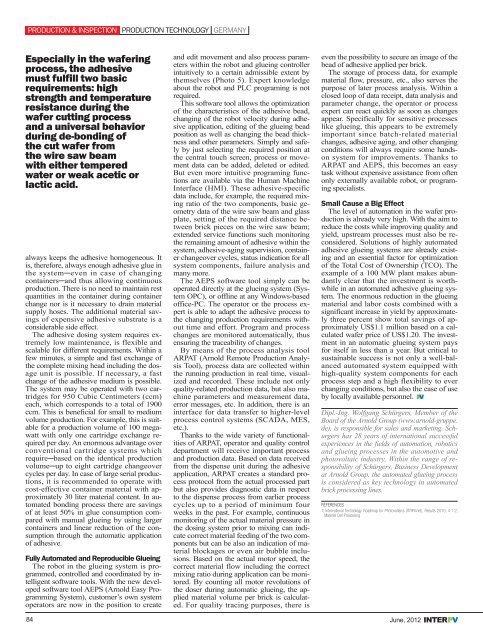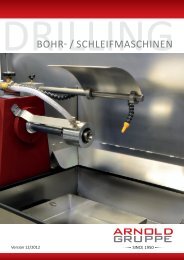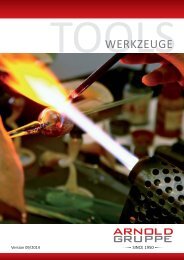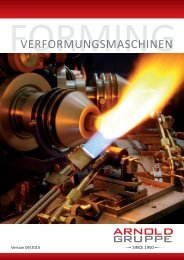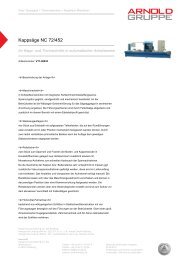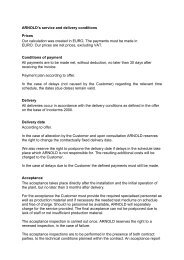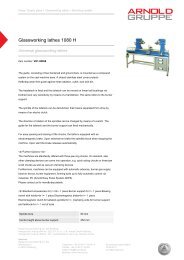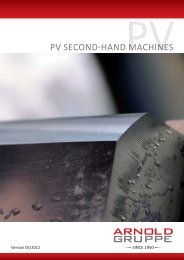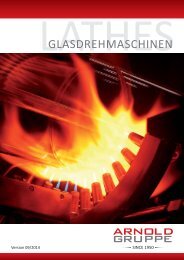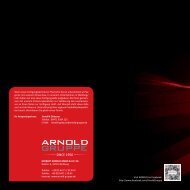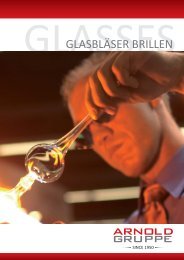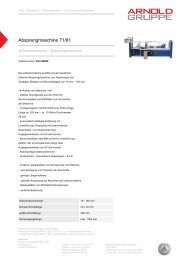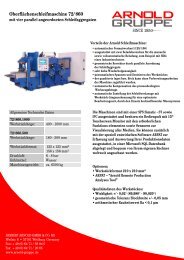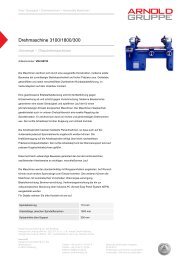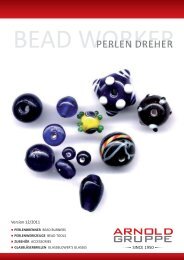You also want an ePaper? Increase the reach of your titles
YUMPU automatically turns print PDFs into web optimized ePapers that Google loves.
Production & Inspection Production Technology Germany<br />
Especially in the wafering<br />
process, the adhesive<br />
must fulfill two basic<br />
requirements: high<br />
strength and temperature<br />
resistance during the<br />
wafer cutting process<br />
and a universal behavior<br />
during de-bonding of<br />
the cut wafer from<br />
the wire saw beam<br />
with either tempered<br />
water or weak acetic or<br />
lactic acid.<br />
always keeps the adhesive homogeneous. It<br />
is, therefore, always enough adhesive glue in<br />
the system─even in case of changing<br />
containers─and thus allowing continuous<br />
production. There is no need to maintain rest<br />
quantities in the container during container<br />
change nor is it necessary to drain material<br />
supply hoses. The additional material savings<br />
of expensive adhesive substrate is a<br />
considerable side effect.<br />
The adhesive dosing system requires extremely<br />
low maintenance, is flexible and<br />
scalable for different requirements. Within a<br />
few minutes, a simple and fast exchange of<br />
the complete mixing head including the dosage<br />
unit is possible. If necessary, a fast<br />
change of the adhesive medium is possible.<br />
The system may be operated with two cartridges<br />
for 950 Cubic Centimeters (ccm)<br />
each, which corresponds to a total of 1900<br />
ccm. This is beneficial for small to medium<br />
volume production. For example, this is suitable<br />
for a production volume of 100 megawatt<br />
with only one cartridge exchange required<br />
per day. An enormous advantage over<br />
conventional cartridge systems which<br />
require─based on the identical production<br />
volume─up to eight cartridge changeover<br />
cycles per day. In case of large serial productions,<br />
it is recommended to operate with<br />
cost-effective container material with approximately<br />
30 liter material content. In automated<br />
bonding process there are savings<br />
of at least 50% in glue consumption compared<br />
with manual glueing by using larger<br />
containers and linear reduction of the consumption<br />
through the automatic application<br />
of adhesive.<br />
Fully Automated and Reproducible Glueing<br />
The robot in the glueing system is programmed,<br />
controlled and coordinated by intelligent<br />
software tools. With the new developed<br />
software tool AEPS (<strong>Arnold</strong> Easy Programming<br />
System), customer’s own system<br />
operators are now in the position to create<br />
84<br />
and edit movement and also process parameters<br />
within the robot and glueing controller<br />
intuitively to a certain admissible extent by<br />
themselves (Photo 5). Expert knowledge<br />
about the robot and PLC programing is not<br />
required.<br />
This software tool allows the optimization<br />
of the characteristics of the adhesive bead,<br />
changing of the robot velocity during adhesive<br />
application, editing of the glueing bead<br />
position as well as changing the bead thickness<br />
and other parameters. Simply and safely<br />
by just selecting the required position at<br />
the central touch screen, process or movement<br />
data can be added, deleted or edited.<br />
But even more intuitive programing functions<br />
are available via the Human Machine<br />
Interface (HMI). These adhesive-specific<br />
data include, for example, the required mixing<br />
ratio of the two components, basic geometry<br />
data of the wire saw beam and glass<br />
plate, setting of the required distance between<br />
brick pieces on the wire saw beam;<br />
extended service functions such monitoring<br />
the remaining amount of adhesive within the<br />
system, adhesive-aging supervision, container<br />
changeover cycles, status indication for all<br />
system components, failure analysis and<br />
many more.<br />
The AEPS software tool simply can be<br />
operated directly at the glueing system (System<br />
OPC), or offline at any Windows-based<br />
office-PC. The operator or the process expert<br />
is able to adapt the adhesive process to<br />
the changing production requirements without<br />
time and effort. Program and process<br />
changes are monitored automatically, thus<br />
ensuring the traceability of changes.<br />
By means of the process analysis tool<br />
ARPAT (<strong>Arnold</strong> Remote Production Analysis<br />
Tool), process data are collected within<br />
the running production in real time, visualized<br />
and recorded. These include not only<br />
quality-related production data, but also machine<br />
parameters and measurement data,<br />
error messages, etc. In addition, there is an<br />
interface for data transfer to higher-level<br />
process control systems (SCADA, MES,<br />
etc.).<br />
Thanks to the wide variety of functionalities<br />
of ARPAT, operator and quality control<br />
department will receive important process<br />
and production data. Based on data received<br />
from the dispense unit during the adhesive<br />
application, ARPAT creates a standard process<br />
protocol from the actual processed part<br />
but also provides diagnostic data in respect<br />
to the dispense process from earlier process<br />
cycles up to a period of minimum four<br />
weeks in the past. For example, continuous<br />
monitoring of the actual material pressure in<br />
the dosing system prior to mixing can indicate<br />
correct material feeding of the two components<br />
but can be also an indication of material<br />
blockages or even air bubble inclusions.<br />
Based on the actual motor speed, the<br />
correct material flow including the correct<br />
mixing ratio during application can be monitored.<br />
By counting all motor revolutions of<br />
the doser during automatic glueing, the applied<br />
material volume per brick is calculated.<br />
For quality tracing purposes, there is<br />
even the possibility to secure an image of the<br />
bead of adhesive applied per brick.<br />
The storage of process data, for example<br />
material flow, pressure, etc., also serves the<br />
purpose of later process analysis. Within a<br />
closed loop of data receipt, data analysis and<br />
parameter change, the operator or process<br />
expert can react quickly as soon as changes<br />
appear. Specifically for sensitive processes<br />
like glueing, this appears to be extremely<br />
important since batch-related material<br />
changes, adhesive aging, and other changing<br />
conditions will always require some handson<br />
system for improvements. Thanks to<br />
ARPAT and AEPS, this becomes an easy<br />
task without expensive assistance from often<br />
only externally available robot, or programing<br />
specialists.<br />
Small Cause a Big Effect<br />
The level of automation in the wafer production<br />
is already very high. With the aim to<br />
reduce the costs while improving quality and<br />
yield, upstream processes must also be reconsidered.<br />
Solutions of highly automated<br />
adhesive glueing systems are already existing<br />
and an essential factor for optimization<br />
of the Total Cost of Ownership (TCO). The<br />
example of a 100 MW plant makes abundantly<br />
clear that the investment is worthwhile<br />
in an automated adhesive glueing system.<br />
The enormous reduction in the glueing<br />
material and labor costs combined with a<br />
significant increase in yield by approximately<br />
three percent show total savings of approximately<br />
US$1.1 million based on a calculated<br />
wafer price of US$1.20. The investment<br />
in an automatic glueing system pays<br />
for itself in less than a year. But critical to<br />
sustainable success is not only a well-balanced<br />
automated system equipped with<br />
high-quality system components for each<br />
process step and a high flexibility to ever<br />
changing conditions, but also the ease of use<br />
by locally available personnel.<br />
Dipl.-Ing. Wolfgang Schürgers, Member of the<br />
Board of the <strong>Arnold</strong> Group (www.arnold-gruppe.<br />
de), is responsible for sales and marketing. Schurgers<br />
has 28 years of international successful<br />
experiences in the fields of automation, robotics<br />
and glueing processes in the automotive and<br />
photovoltaic industry. Within the range of responsibility<br />
of Schürgers, Business Development<br />
at <strong>Arnold</strong> Group, the automated glueing process<br />
is considered as key technology in automated<br />
brick processing lines.<br />
REFERENCES<br />
1) International Technology Roadmap for Photovoltaics (ITRPV.net), Results 2010; 4.1.2,<br />
Material Cell Processing<br />
June, 2012


